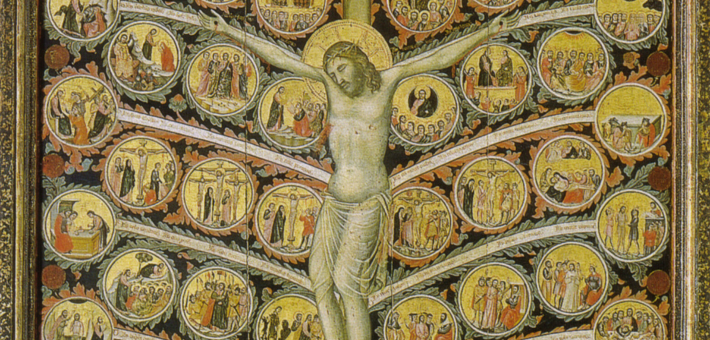Commentary on John 18:1—19:42
Nothing displayed Roman power like crucifixion, an act designed to publicly execute revolutionaries and slaves with utmost shame and disgrace as a means of punishment, cruel amusement, and deterrence for revolutionaries present and future. Josephus describes the crucifixion of thousands of Jews during the siege of Jerusalem (70 CE) in the first war with Rome, many of whom were starving refugees trapped in the city. They were deterred from foraging beyond Jerusalem’s walls by Jewish revolutionaries who would execute them and their families for desertion, yet were forced out by famine only to be captured and crucified by the Romans.
Josephus writes chillingly, “So the soldiers, out of the wrath and hatred they bore the Jews, nailed those they caught, one after one way, and another after another, to the crosses, by way of jest, when their multitude was so great that room was wanting for the crosses, and crosses wanting for the bodies.”1
For the readers of John, written in the traumatic aftermath of this war and hurtling toward the cataclysmic second war (132–135 CE), the crucifixion of Jesus would be understood as a prophetic foreshadowing and in profound solidarity with all those non-combatants hungry for peace and life in the face of overwhelming death. John takes Jesus’ crucifixion, intended by Rome as a triumphant display of Roman power and glory over a humiliated enemy, and narrates it as the victory of God over the forces of death and dominion, a victory achieved by the self-controlled and unflappable martyrdom of Jesus. Today, in yet another time of war, famine, immense suffering, and death in Judea and Palestine (and elsewhere), we do well to return to John’s Passion for a renewed vision of peace, resilient agency, and life.
The lectionary passage begins under the cover of darkness with the arrest of Jesus at the hands of soldiers from both Rome and the chief priests and Pharisees (18:1–3), highlighting the alliance of powerful elites arrayed against Jesus. No identifying kiss from Judas is needed in John, and unlike in Mark’s Gospel, Jesus does not fall to the ground and plead that this hour might pass from him. Instead, the Light of the World (8:12; 9:5; 11:9; see also 1:4–5) steps forward and the cohorts of darkness fall back at Jesus’ invocation of the divine name: “I am” (18:4–7; see also 8:24; Exodus 3:14).
Rejecting apprehension (see also 10:17–18; 1:5), Jesus offers himself in place of his accompanying disciples (18:8–9; see also 17:12), and he affirms the anti-violent path of liberation given to him by God, rebuking Peter for his attack on the high priest’s slave Malchus (18:10–11). We see clearly here John’s insight that the power to overcome violence comes not from violence, but rather from sacrificial love (see also 13:1; 15:13) and from light that eschews both flight and fight.
From there, Jesus (bound and beaten, yet ever unbowed) is paraded before both high priests and Pilate, where his innocence is interrogated (18:23, 29–38) and repeatedly pronounced (18:38; 19:4, 6). These scenes are intermixed with episodes of Peter, and whereas Jesus actively responds when challenged—no silent lamb led to slaughter (1:29, 36; 19:14; see also Isaiah 53:7)—Peter denies being a disciple, three times responding, “I am not” (a bitter and tragic inversion of Jesus’ “I am”).
Jesus’ confrontation with Pilate, the face of empire in Judea and emissary of the imperial “ruler of this world” (12:31; 14:30; 16:11), displays most clearly Jesus’ distinct path of liberation apart from violent revolution. Jesus insists to Pilate, “My kingdom is not from this world. If my kingdom were from this world, my followers would be fighting to keep me from being handed over” (18:36). Rather, Jesus’ mission and power is his testimony to the truth (18:37), a revelation that unmasks the myth of violence and domination (see also 8:31–59).
Pilate, refusing to listen to this voice, cynically responds, “What is truth?” before sitting on the judgment seat (19:13) and presiding over this cosmic miscarriage of justice and sham of Roman “law and order.”
Jesus’ distinct path of liberation stands apart from the other postures toward Rome displayed as foils in this passage. Though united in their opposition to Jesus, we see starkly different sentiments displayed by the various Jewish groups depicted. On the one hand, we see the powerful chief priests aligned with Roman rule, who go beyond sending officers to join the Roman cohort at Jesus’ arrest (18:1–8) to ultimately proclaiming, “We have no king but the emperor” (19:15), an existential inversion of the zealous revolutionary cry “No King but God!”2
Conversely, the Judeans clamor for the release of Barabbas, the anti-Roman insurrectionist (18:40; cf. 10:8–10). Though divided in causes, all three parties (Pilate, the chief priests, and Judeans) are united in the perception of the threat Jesus’ path to liberation and life poses to them, a union begun in the raising of Lazarus that set in motion their resolve to kill Jesus (see also 11:45–53; 12:9–11; 18:14), and they join in sending him off to his wrongful execution. Jesus, however, remains in control until the end, pronouncing, “It is finished,” then bowing his head and handing over his spirit (19:30).
Notably, though Jesus’ anti-violent resistance to the forces of death is ultimately endorsed by God in the resurrection of Jesus as the true way of faithfulness (see also 14:6), his betrayal and crucifixion are both condemned as sin (19:11), making clear that God neither requires nor desires the death of Jesus to bring salvation (contrary to the penal substitution theory in Christian theology). In addition to the multiple metaphors of salvation in John (including spiritual union with God [17:20–23] and spiritual rebirth [3:3–8]; see also 1:12–13), John takes the death that Rome intended for shame and dominion and transforms it into a sacred sacrifice of liberation, evoking the Passover liberation by placing Jesus’ crucifixion at the same time as the sacrifice of the lambs for Passover (19:14).
The transformation of death into life is completed by the birth imagery evoked in the eruption of blood and water when Jesus’ side is pierced (19:34). For all who struggle and die in pursuit of peace, truth, and justice—especially peacemakers in Palestine, Israel, and throughout the world—John’s portrait of Jesus’ martyrdom shows the life, love, freedom, and rebirth that are possible in active resistance.
Notes
- Judean War, 5.11.1.
- For example, Josephus, War, 2.8.1.


April 18, 2025